Table of contents of the article
TogglePotato scab is a bacterial disease that affects potato tubers, leading to their deformation and reduced quality. This article from the “WORLD OF PLANTS” website reviews effective prevention and control methods.
Introduction to potato scab
- Name of the disease: Try potatoes
- Scientific name: Streptomyces spp.
- Type of disease: Bacterial pathogen
- Disease family: Streptomycetaceae
Potato scab disease, caused by bacteria (Streptomyces scabie), is a common and persistent problem for potato growers around the world. This undesirable disease, which often causes economic damage, affects the tubers and, in some cases, the surface tissues of the plant. In this article, we will review the life cycle of the pathogen, early symptoms, conditions suitable for the disease, and effective control methods to reduce the impact of potato scab on the production and quality of the crop.
Life cycle of potato scab
Understanding the life cycle of Streptomyces scabies is essential for implementing effective control strategies. The bacteria live in the soil and plant waste, where they persist between growing seasons. When conditions are right, such as warm and moist soil, bacteria produce seeds called conidia. These seeds can survive for long periods, waiting for the opportunity to infect susceptible potato plants.
When seeds meet a suitable host, such as potatoes, the seeds germinate and the bacteria penetrate the plant tissue through natural openings or wounds. Once inside, they form characteristic pigmentation on the surface of the tuber, which is detrimental to its quality. Bacteria can also infect the plant during the growing season, causing surface blemishes on the stems, leaves and even tubers.
Symptoms of potato scab
Early detection of potato disease is essential for effective control. Initial symptoms often appear during tuber development and include small, raised lesions on the surface of the potato. These ulcers can have a rough texture and can vary in color from brown to woody or crusty. While early symptoms may be subtle, it is important to monitor plants carefully during the growing season to detect anything abnormal, as potato scab can reduce the quality and quantity of production, affecting the commercial value of the crop.
As the disease progresses, cankers on tubers become more noticeable, and their impact on crop production and quality becomes greater. Symptoms can range in severity, from superficial cracking to deep, perforated sores. In severe cases, affected tubers may be irregular in shape or appear deformed. In addition, cankers can spread to the leaves and stems of the plant, causing cracks or raised cankers.
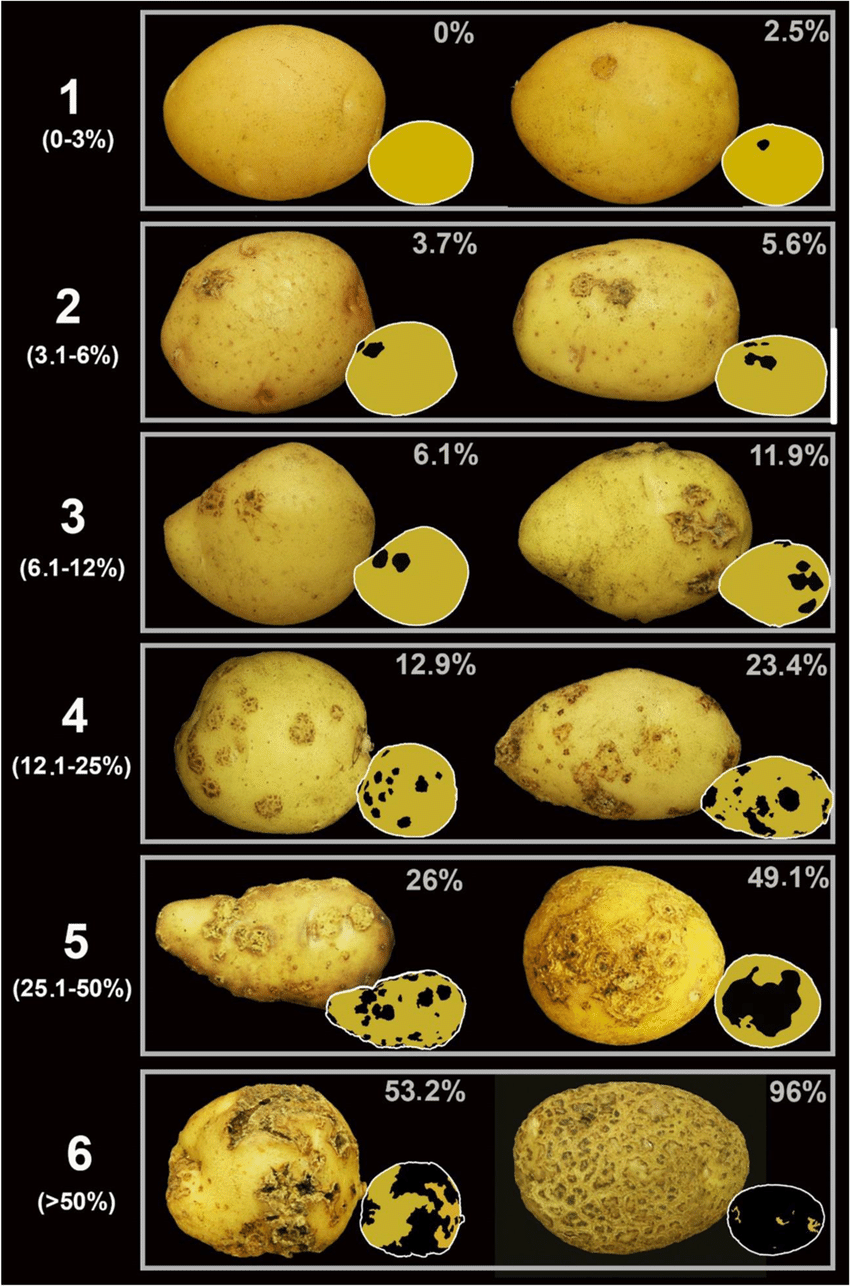
To accurately identify potato scab, it is important to distinguish it from other common potato disorders and diseases. Carrying out careful visual inspections of tubers and plants, especially during the tuber development stage, is essential for early detection and immediate action.
Causes of potato scab
Several factors contribute to the return of potato scab as a devastating pest. Soil acidity levels, the presence of excessive amounts of organic matter, and the presence of a source of infection in the form of infected potato seeds or contaminated irrigation water play a vital role in the introduction and spread of bacteria.
Suitable conditions for potato scab disease
Potato scab bacteria react well in soil conditions that are slightly acidic to neutral, with pH levels between 5.5-7.0 being optimal. Sufficient ground moisture and high temperatures promote further development of the disease. Potato scab is most likely to occur during the growing season, which usually extends over the warmer months of the year. In pleasant climates, this corresponds to a period from the end of spring to the beginning of fall. The exact months can change depending on the local climate and geographic location. Implementing preventive measures during the growing season and improving soil conditions are vital to protect potato crops from potato scab. Potato scab is more prevalent in open field agriculture as a result of favorable soil conditions. While greenhouses, with their structured environments, reduce the risk of disease development.
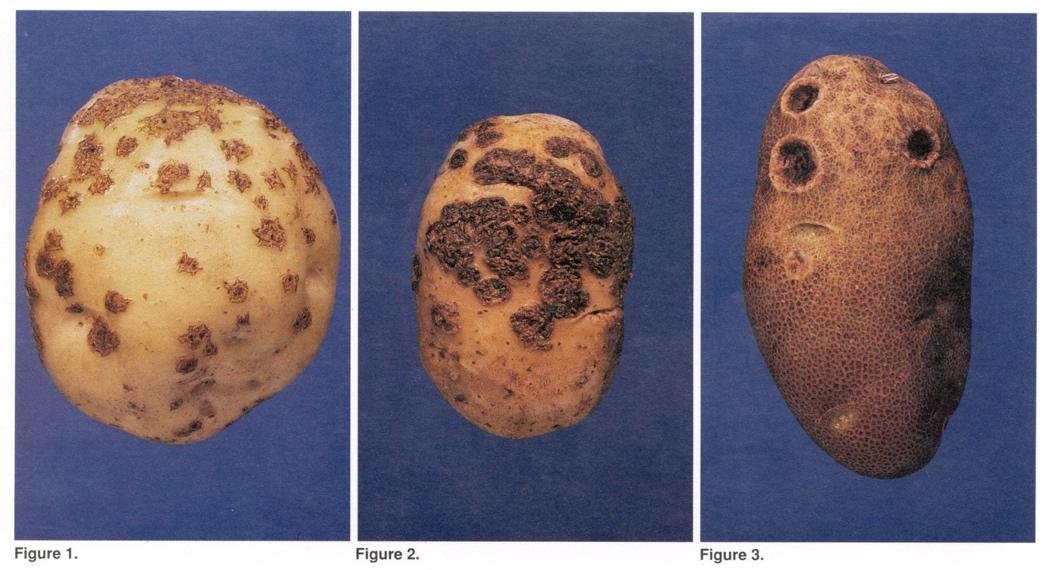
Losses due to potato scab infection
Potato scab disease poses a major threat to potato crops, affecting their marketability and economic returns. While lesions are often superficial and affect only the skin of the tuber, severe infestations can lead to deeper tissue damage, making potatoes unattractive to consumers and produce processors.
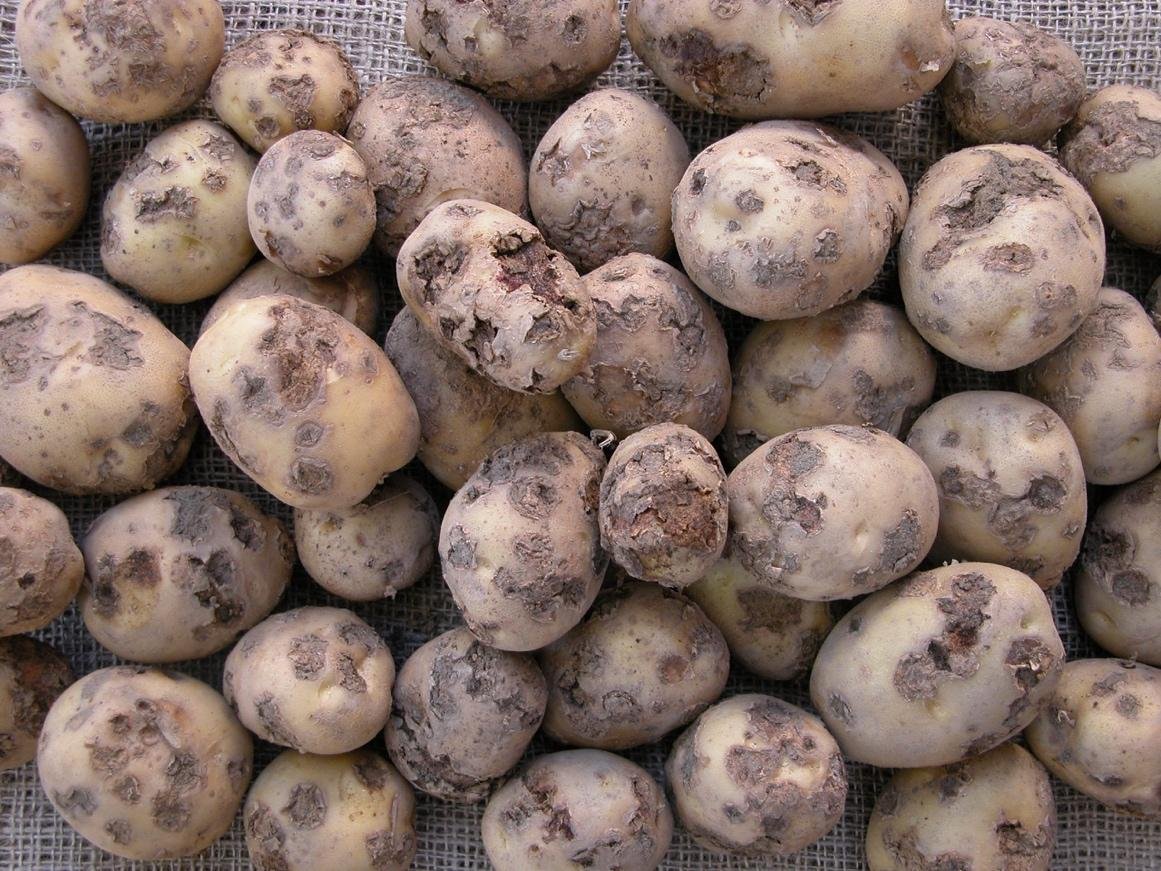
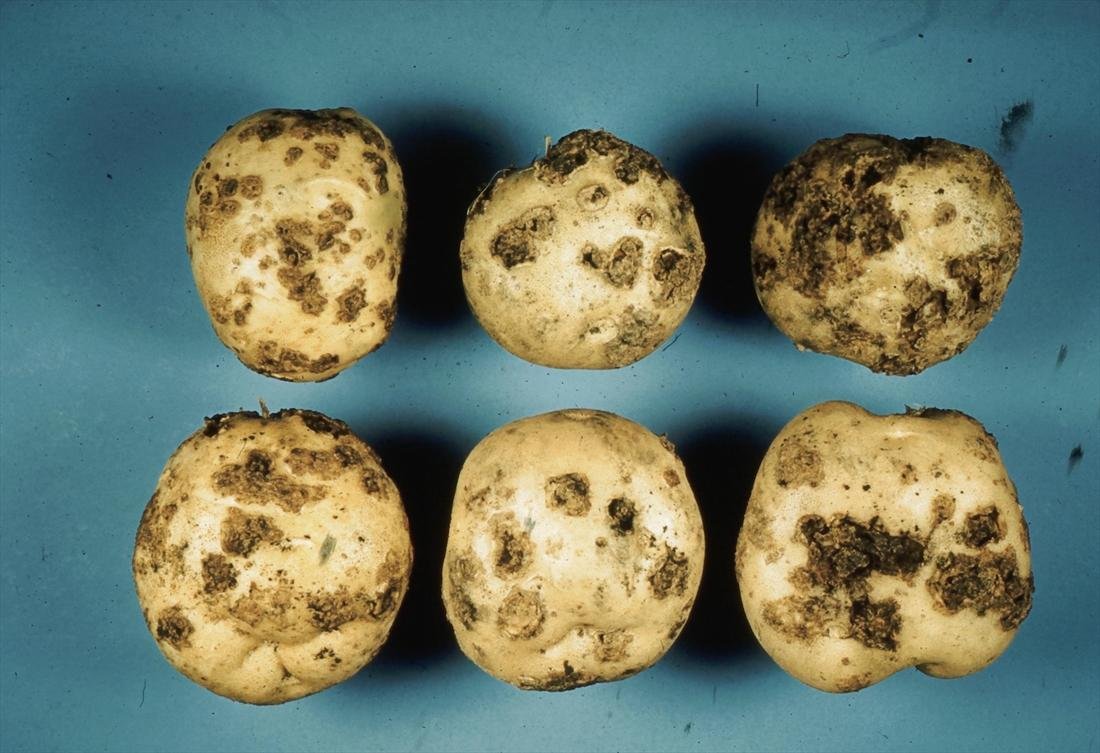
Potato scab control strategy
Effectively managing potato scab requires a comprehensive approach, including agricultural, chemical and organic practices.
• Agricultural practices: Practices such as maintaining proper soil pH, avoiding excessive amounts of organic matter, and practicing crop rotation are essential to reduce the risk of potato scab. In addition, selecting potato varieties resistant to potato scab contributes to effective cultural control.
• Chemical control: Managing potato scab in potatoes using chemical treatments poses challenges due to their potential to cause damage to plants. However, seed treatments with fluazinam, chlorothalonil and mancozeb showed the lowest incidence of infection. Copper-based fungicides and biocides containing Bacillus spp are also shown. Effective in reducing the severity of potato scab.
• Organic control: Organic crop growers can incorporate practices such as organic fertilization and use of organic amendments to enhance soil health and reduce the likelihood of potato scab. Application of organic extracts such as fertilizer, compost tea, or a combination of these treatments significantly reduces the severity of common potato scab on tubers. Plant extracts with antimicrobial properties, such as chamomile or garlic, can also be incorporated into an organic control plan.
Preventive measures for potato scab disease
Effective prevention plays a crucial role in mitigating the risk of spreading potato scab. Implementing a comprehensive package of preventive measures is vital to enhance the resilience of potato crops and maintain their resilience against the devastating impact of scab. Key preventive measures include:
• Choosing disease-resistant varieties: Start by identifying scab-resistant potato varieties to establish a strong defense against potato scab.
• Improving soil conditions: Maintain optimal soil pH (about 5.1) and moisture levels during the first 2 to 6 weeks after tuber formation to create an unfavorable environment for potato scab to develop. Use zinc sulphur, gypsum or ammonium sulphate to keep soil acidity low and reduce the impact of disease. Avoid using lime before planting.
• Choose tubers carefully: Use certified disease-free potato tubers to minimize the introduction of potato scab pathogens.
• Agriculture cycle: Rotate crops with non-host crops to break the potato scab cycle.
• Monitor and remove infected plants: Inspect the field regularly for signs of potato scab and remove infected plants quickly to prevent the spread of the disease.
• Balanced fertilization: Avoid excessive fertilization, especially with high-organic matter, to reduce the risk of potato scab.
• Proper post-harvest handling: Be sure to carefully follow post-harvest handling and storage practices to prevent potato scab from developing during the storage period.
• Responsible disposalDispose of infected plant material responsibly to reduce the risk of soil contamination with potato scab pathogens.
Adherence to these preventive measures collectively contributes to building a strong defense against potato scab disease in potatoes, ensuring the health and productivity of potato crops throughout their growth period.
Conclusion
In conclusion, the persistent threat of potato scab disease in potato production requires consistent attention and effective management.
Streptomyces spp. As a pathogen, it requires a comprehensive approach for sustainable control. The insights shared in this article highlight the importance of caution, early detection and integrated pest management.
The potential for potato scab to cause economic losses is a reality that farmers must face. Collaboration between researchers, farmers and decision-makers becomes crucial to overcome emerging challenges and secure the future of sustainable potato production. By implementing the preventive measures mentioned here, potato growers can strengthen their defenses against this bacterial disease.
Moving forward, staying informed, adopting innovative strategies, and strengthening collective dedication to agricultural resilience are imperative. Potato scab may remain, but through shared knowledge and collaborative efforts, we can grow potato crops that thrive, ensuring food security and economic well-being for farming communities.
We would like to point out that we, on the World of Plants website, provide you with all the services you need in the world of plants. We provide all farmers and those interested in plants with three main services: -
- Artificial intelligence consulting service to help you identify diseases that affect plants and how to deal with them.
- Blog about plants, plant diseases and care of various crops ... You are currently browsing one of her articles right now.
- An application that provides agricultural consultations to clients, as well as a service for imaging diseases and knowing their treatment for free – Click to download the Android version from Google Play Store، Click to download the IOS version from the Apple App Store.
Sources:
- Lehman, W. L., & Lacy, M. L. (2009). Potato scab: A review. The American Phytopathological Society, 93(12), 1156–1173.
- Rosenzweig, N., Turechek, W., Stevenson, W., & Bartz, J. (2016). Potato scab. University of Florida IFAS Extension. Retrieved from https://edis.ifas.ufl.edu/pdffiles/PG/PG00023.pdf
- Loria, R., Bukhalid, R. A., & Fry, B. A. (1997). The role of thaxtomin A in the potato scab pathosystem. Phytopathology, 87(4), 418-423.
- Wanner, L. A., & Kirk, W. W. (2017). The impact of Streptomyces spp. on plant diseases. In Streptomyces – Basics and Biotechnological Applications (pp. 229-254). InTech.
- Potato Scabs – plantix




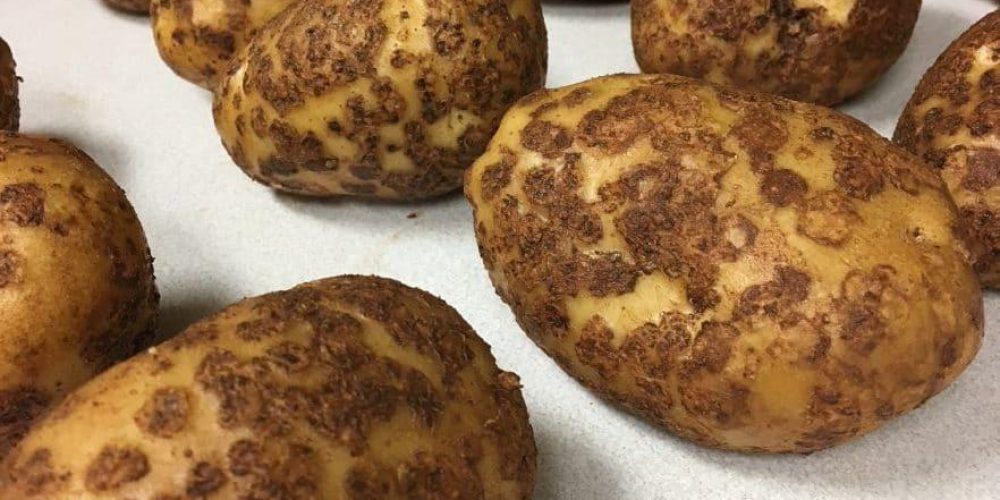
2 Comments
السلام عليكم
معلومات قيمة .
وعليكم السلام ورحمه الله وبركاته
شكرا لك